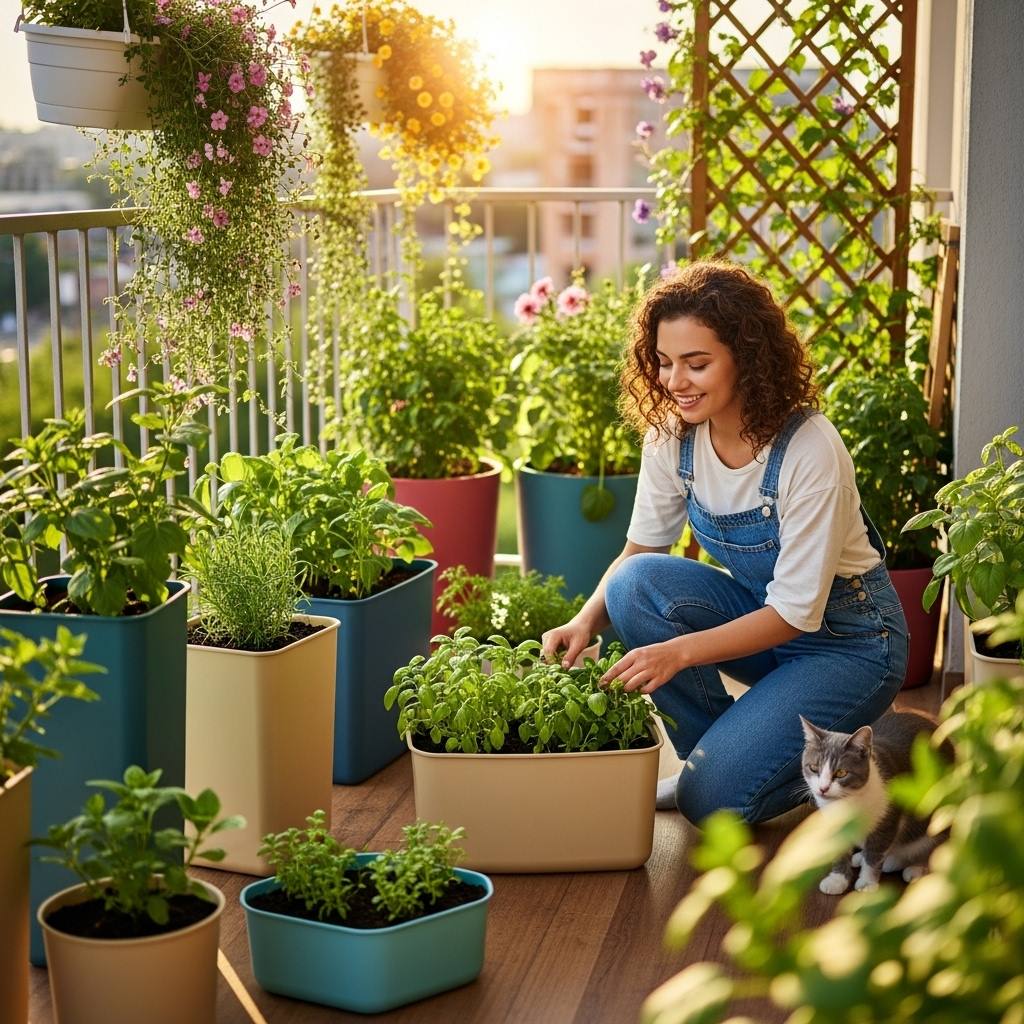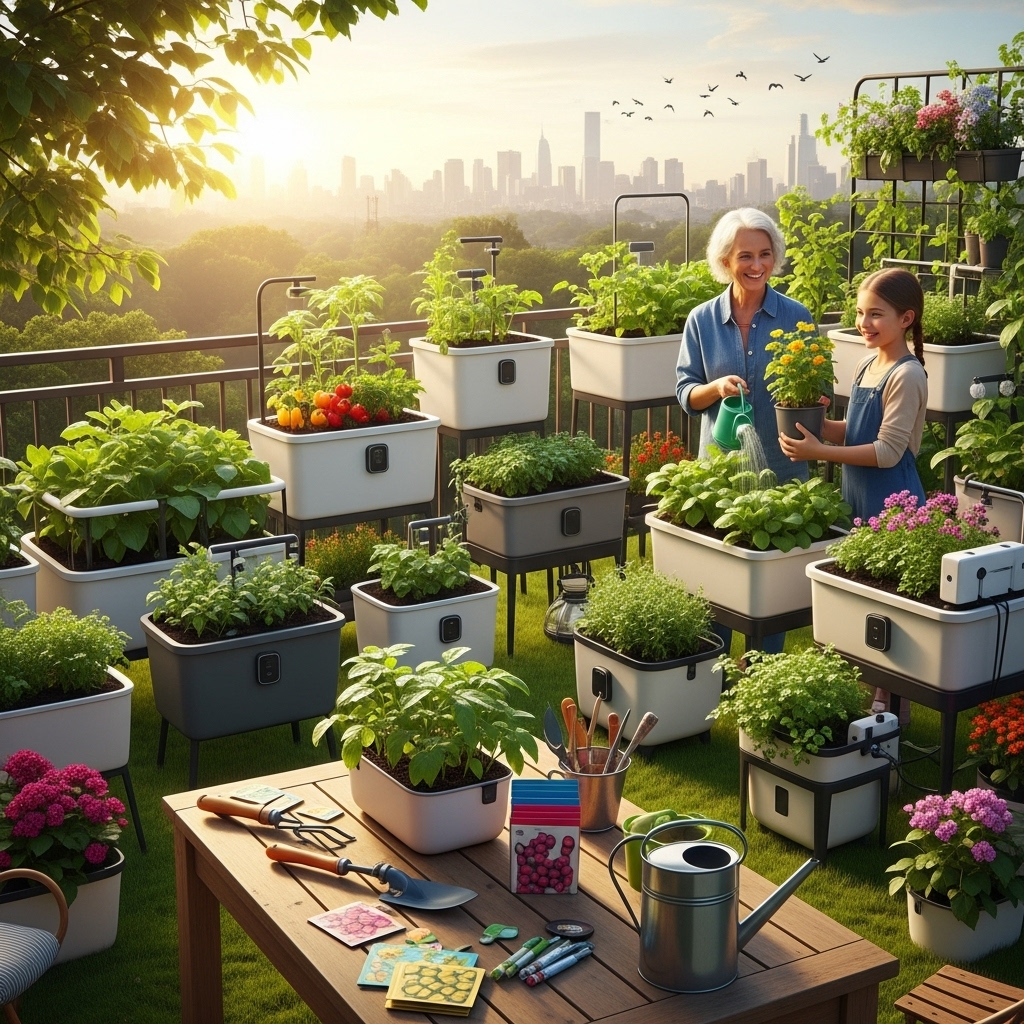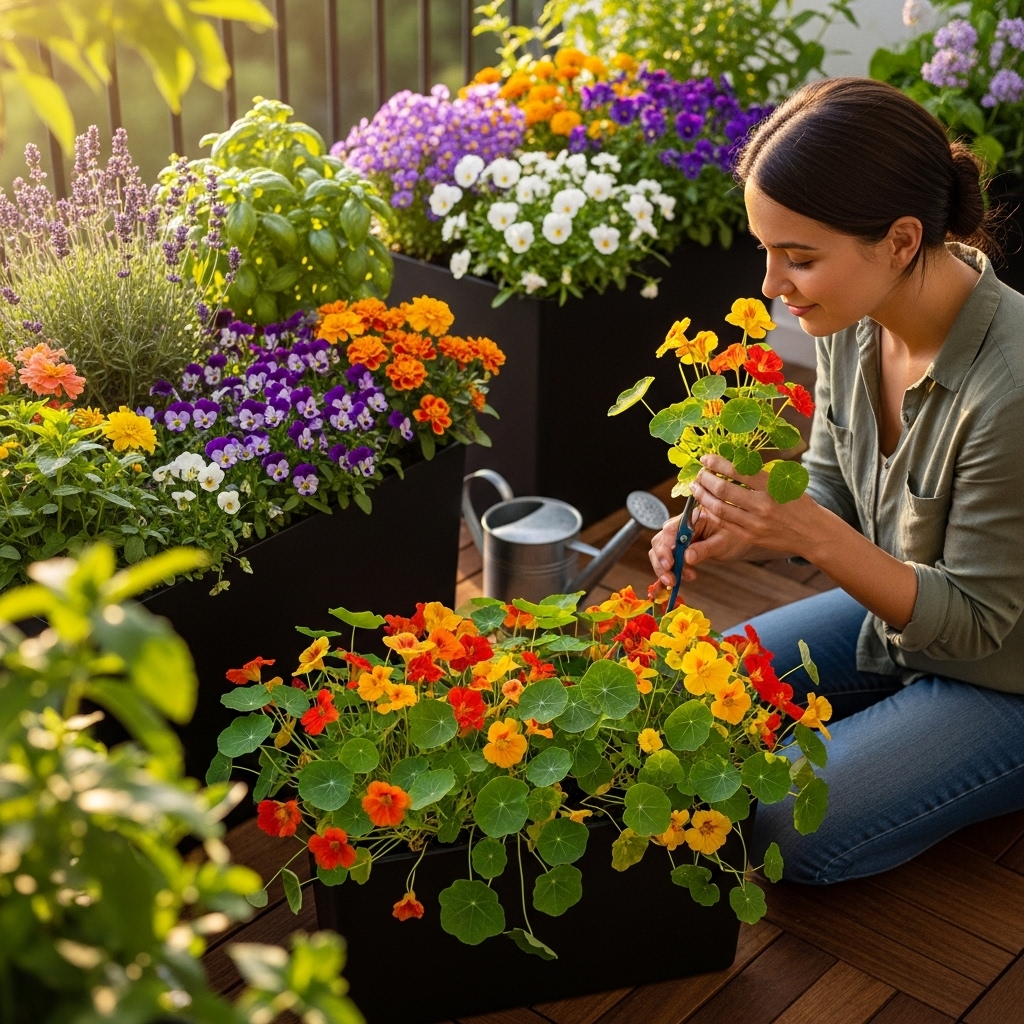Have you ever dreamed of fresh herbs or vibrant veggies gracing your meals, but lack a garden? Don’t worry; with smart containers, I discovered I can grow almost anything, anywhere! Let’s dive into the world of container gardening.
Understanding Container Gardening

Container gardening has completely transformed my perspective on growing plants. I used to think that gardening was an exclusive domain for those with spacious backyards or sunny plots of land. However, after experimenting with container gardening, I realized that this method opens a world of possibilities for everyone, especially urban dwellers and those with limited space. It’s not just about aesthetics; container gardening can provide fresh produce and herbs right at your doorstep.
The Basics of Container Gardening
To kick off my journey into container gardening, I learned about the essentials. First and foremost, choosing the right container is crucial. The options are endless — from traditional terracotta pots to innovative self-watering containers. I found that the best containers have drainage holes to prevent root rot, allowing excess water to escape. This simple feature helps maintain the right moisture level, which is vital for healthy plant growth.
Next, I needed to consider the soil. Not just any dirt will do! I discovered that a high-quality potting mix designed for container gardening offers the right balance of nutrients, drainage, and aeration. This mix usually contains a blend of peat moss, vermiculite, and compost, which made my plants thrive better than any garden soil I ever used.
Choosing the Right Plants
Now that I had my containers and soil sorted, it was time to decide what to plant. I realized that not every plant thrives in a confined space, so I began researching the best candidates for container gardening. I found that herbs like basil, parsley, and mint flourish in pots. I also discovered that many vegetables, such as tomatoes, peppers, and even small varieties of cucumbers, can thrive in containers too!
I decided to start with herbs since they require less space and are incredibly rewarding. Every time I snipped a few leaves for my dishes, I felt a sense of accomplishment. I learned that placing my herbs in a sunny spot, ideally with 6-8 hours of direct sunlight, was key to their success. Interestingly, I found that rotating the pots every few days helps ensure even growth, as the plants reach towards the sun.
Watering and Maintenance
One of the most significant aspects of container gardening that I had to master was watering. Containers tend to dry out faster than garden beds, so I quickly learned that consistent watering was essential. I adopted a routine of checking the moisture level by sticking my finger into the soil — if it felt dry an inch down, it was time to water. I also discovered the benefits of self-watering containers, which have a reservoir that keeps the soil consistently moist, taking some pressure off my daily routine.
Additionally, I found that container plants often benefit from regular feeding. I began using liquid fertilizers every few weeks to provide nutrients that the plants might not get from the potting mix alone. This simple step resulted in lush, healthy plants that produced abundantly.
Maximizing Space with Vertical Gardening
As I continued my container gardening journey, I became intrigued by the concept of vertical gardening. This innovative approach allowed me to maximize my limited space by stacking containers or using wall-mounted planters. I discovered that herbs, strawberries, and even some leafy greens could grow vertically, adding visual interest and saving precious floor space.
To create my vertical garden, I used tiered plant stands and wall-mounted planters. One of my favorite projects was building a simple vertical herb garden from repurposed wooden pallets. It not only looked great but also made harvesting easier, as everything was within arm’s reach. I loved how this method allowed me to experiment with more plants without feeling cramped.
Dealing with Pests and Diseases
Of course, no gardening experience is complete without facing a few challenges. I encountered pests and diseases that threatened my thriving container plants. However, I quickly learned that container gardening can be less prone to certain pests, as I had more control over the environment. I became diligent in monitoring my plants for signs of trouble. If I spotted aphids or spider mites, I would wash them off with water or apply a mild insecticidal soap to keep them at bay.
Moreover, I found that rotating my crops and keeping my containers clean helped prevent the spread of diseases. Regularly removing dead leaves and debris not only kept my garden looking tidy but also reduced the chances of diseases taking hold.
As I continue to explore the world of container gardening, I find that the possibilities are truly endless. From choosing the right containers to selecting the perfect plants, every step has been a rewarding learning experience. I can’t wait to share more about my adventures with container gardening and the amazing plants I’ve grown in this confined space. Stay tuned for the next part, where I dive deeper into specific plant varieties and advanced techniques to elevate your container gardening game!
Exploring Advanced Container Gardening Techniques

As I delved deeper into container gardening, I started to explore advanced techniques that could enhance my gardening experience and yield even better results. One of the most exciting concepts I came across was companion planting. I quickly learned that certain plants thrive when grown together, and this strategy can be particularly beneficial in a container gardening setup.
For example, I discovered that growing basil alongside tomatoes not only maximizes space but also enhances the flavors of both plants. Basil repels pests that typically target tomatoes, making this pairing a win-win. I also learned about the benefits of planting marigolds in my containers, as they attract beneficial insects and deter harmful ones. This simple yet effective technique not only improved my garden’s health but also made it a more vibrant and lively space.
Utilizing Hydroponics in Containers
Another fascinating avenue I wanted to explore was hydroponics. This soil-less method of growing plants utilizes nutrient-rich water to support plant growth, which can be an excellent option for container gardening. I started by setting up a simple hydroponic system using plastic containers and a nutrient solution. The results were astonishing! My plants grew faster and healthier than I ever imagined.
One of my favorite hydroponic plants has been lettuce. I was amazed at how quickly it flourished without the traditional soil constraints. The water retention in my hydroponic setup ensured that the plants had consistent access to moisture, and I found it incredibly rewarding to harvest fresh, crisp lettuce for my salads. While it took a bit of trial and error to perfect my technique, the convenience and efficiency of hydroponics in containers made it well worth the effort.
Season Extension Techniques
As I got more comfortable with my container gardening, I wanted to extend my growing season. I learned that there are various techniques to help protect my plants from temperature fluctuations. One method I found particularly helpful was using row covers or cloches. These simple structures trap heat around the plants, shielding them from colder temperatures and enabling me to start my planting earlier in the spring and extend it later into the fall.
I remember one chilly evening when a sudden frost was predicted. I quickly covered my containers with row covers, and the next day, I was relieved to find my plants unharmed. This experience taught me the value of being proactive in gardening. Investing in a few simple tools to extend my growing season has allowed me to enjoy fresh produce for longer, which is a definite bonus!
Experimenting with Succession Planting
Another advanced technique that piqued my interest was succession planting. I learned that by staggering my planting dates, I could ensure a continuous harvest throughout the growing season. For example, I planted a container of radishes every two weeks. This method allowed me to enjoy fresh radishes all summer long without overwhelming myself with a single harvest.
By applying succession planting to various crops, such as lettuce and beans, I realized how much more efficient my container garden could be. Instead of having a massive crop of one kind of vegetable at once, I now have a steady supply that keeps my kitchen stocked with fresh ingredients. It’s all about timing and planning, which has made me much more organized in my gardening endeavors.
Integrating Technology into Container Gardening
As technology continues to evolve, I found that there are numerous gadgets and tools available that can enhance my container gardening experience. For instance, I started using smart sensors that monitor soil moisture levels and send notifications to my phone when it’s time to water. This technology not only saves me time but also helps prevent over- or under-watering, which can be particularly challenging in containers.
Additionally, I discovered the benefits of using grow lights for indoor container gardening. When winter rolled around, I didn’t want to stop gardening, so I set up a grow light system to ensure my plants received adequate light even in the darker months. The results were remarkable! My herbs and greens thrived indoors, and I was able to maintain my gardening passion year-round.
Sharing the Gardening Journey
One of the most enriching aspects of my container gardening experience has been sharing my journey with others. I began documenting my progress on social media and connecting with fellow gardening enthusiasts. I found that exchanging tips, successes, and even challenges could be incredibly uplifting. There’s something special about celebrating achievements and learning from setbacks together as a community.
Also, I started hosting small gatherings with friends and neighbors to share my homegrown produce. There’s a unique joy in sharing the fruits (and herbs) of my labor with others. Whether it’s whipping up a fresh pesto sauce or enjoying a salad made from my homegrown lettuce, these moments have enriched my gardening experience beyond mere cultivation.
My journey into container gardening has evolved into a multifaceted adventure filled with learning, experimentation, and joy. From advanced techniques like companion planting and hydroponics to sharing my passion with others, every step has deepened my connection to gardening. I’m excited to see where this path leads me next!
Exploring Edible Flowers in Container Gardening

Along my container gardening journey, I stumbled upon the delightful world of edible flowers. I never knew that flowers could be more than just beautiful additions to my garden; they could also enhance my meals! I was intrigued by the idea of incorporating visually appealing blooms that are not only edible but also packed with flavor and nutrients.
One of the first edible flowers I tried was nasturtium. I learned that these vibrant flowers are not only stunning with their bright orange and yellow hues but also have a peppery taste that adds a unique kick to salads. I was amazed at how easy they are to grow in containers. With just a bit of sunlight and regular watering, my nasturtium plants flourished, and soon enough, I was harvesting their lovely blooms to garnish my dishes.
Another favorite of mine became calendula, also known as pot marigold. These cheerful flowers not only brightened up my garden but also offered a range of culinary possibilities. The petals can be used in salads, as a colorful garnish, or even infused into oils for cooking. I was surprised to learn about their medicinal properties as well, which made me appreciate them even more!
To successfully grow edible flowers, I discovered that it’s essential to choose varieties that are safe and organic. I made sure to source seeds from reputable suppliers that guarantee no harmful pesticides or chemicals were used. This commitment to safety ensured that I could enjoy my flowers without any harmful effects on my health.
Creating a Pollinator-Friendly Container Garden
As I continued to explore different plants, I felt compelled to do my part in supporting local pollinators. I learned that creating a pollinator-friendly container garden could attract bees, butterflies, and other beneficial insects, which in turn helps my plants thrive. I began to incorporate a variety of flowering plants that provide nectar and pollen for these vital creatures.
One of my first additions was bee balm, a stunning plant with vibrant red, pink, and purple flowers that seem to draw in pollinators like a magnet. I also planted lavender, which not only smells wonderful but is a fantastic nectar source for bees. Having these plants in my garden made me feel like I was contributing positively to the ecosystem.
I made sure to create a diverse container garden with a variety of bloom times. By selecting plants that flower at different stages throughout the growing season, I ensured that pollinators would have a consistent food source. Watching bees buzz around my containers and butterflies flutter from plant to plant brought me immense joy and satisfaction.
Container Gardening for Sustainability
As I learned more about container gardening, I became increasingly interested in sustainable practices. I realized that gardening in containers can be an eco-friendly way to grow food with a minimal environmental footprint. One of the first steps I took was to utilize recycled materials for my containers. I repurposed old wooden crates, tin cans, and even plastic bottles to create unique planters. It felt great to give new life to these items while reducing waste.
I also started composting my kitchen scraps to create nutrient-rich compost for my container garden. The process was surprisingly easy, and I loved the idea of turning waste into valuable resources for my plants. I noticed a significant improvement in the health of my plants when I incorporated compost into my potting mix. This practice not only supported my gardening efforts but also contributed to reducing landfill waste.
Another sustainable technique I adopted was rainwater harvesting. I set up a simple rain barrel to collect water runoff from my roof. This initiative provided a natural and free source of water for my plants, allowing me to conserve tap water while nourishing my container garden. The sense of satisfaction that came from utilizing nature’s resources was unmatched.
Seasonal Themes in Container Gardening
As my container gardening skills grew, I found joy in creating seasonal themes. Decorating my containers not only showcased my personality but also allowed me to celebrate different times of the year through my gardening. For instance, in the spring, I focused on vibrant blooms like petunias and pansies that added color to my space after a long winter. In summer, I transitioned to lush herbs and vegetables, embracing the bounty of the growing season.
During the fall, I experimented with ornamental kale, colorful chrysanthemums, and pumpkins to create a festive display. I loved how these seasonal changes brought a fresh perspective to my garden, making it a dynamic space that continually evolved. It was a wonderful way to engage with the changing seasons while enjoying the fruits of my labor.
As I reflect on my container gardening journey, I’m grateful for the lessons I’ve learned and the experiences I’ve gained. Each new endeavor, from edible flowers to sustainable practices, has added depth to my gardening adventures. I’m excited to keep pushing the boundaries of what I can achieve in my container garden and to discover new techniques that will elevate my gardening experience even further!
Final Thoughts
The journey through container gardening has been a transformative experience for me, filled with creativity, joy, and a deep connection to nature. From nurturing my first herbs to exploring advanced techniques like hydroponics, every element has enriched my life in unexpected ways. I am thrilled to continue this adventure and share my knowledge with others, encouraging them to explore the vibrant world of gardening, no matter how limited their space may be. The possibilities are endless, and I can’t wait to see what I’ll discover next!
